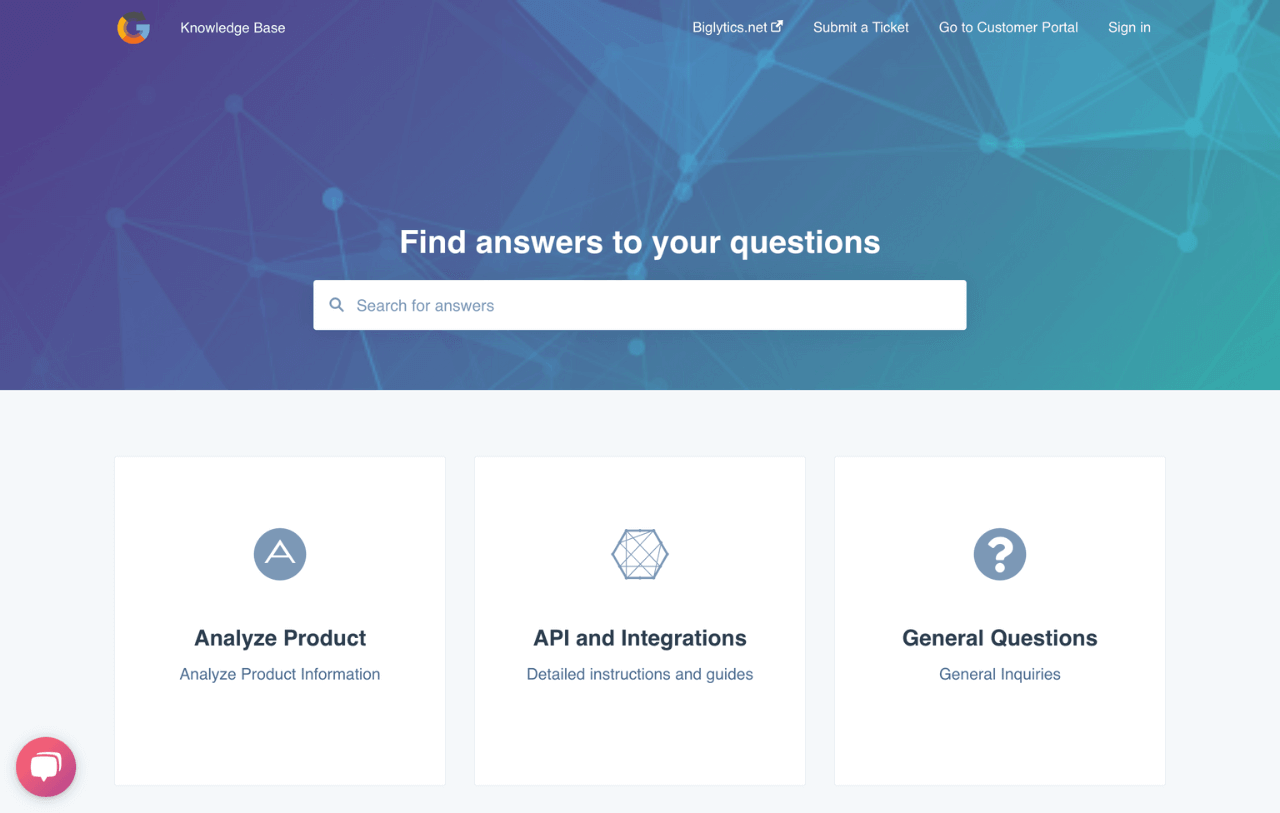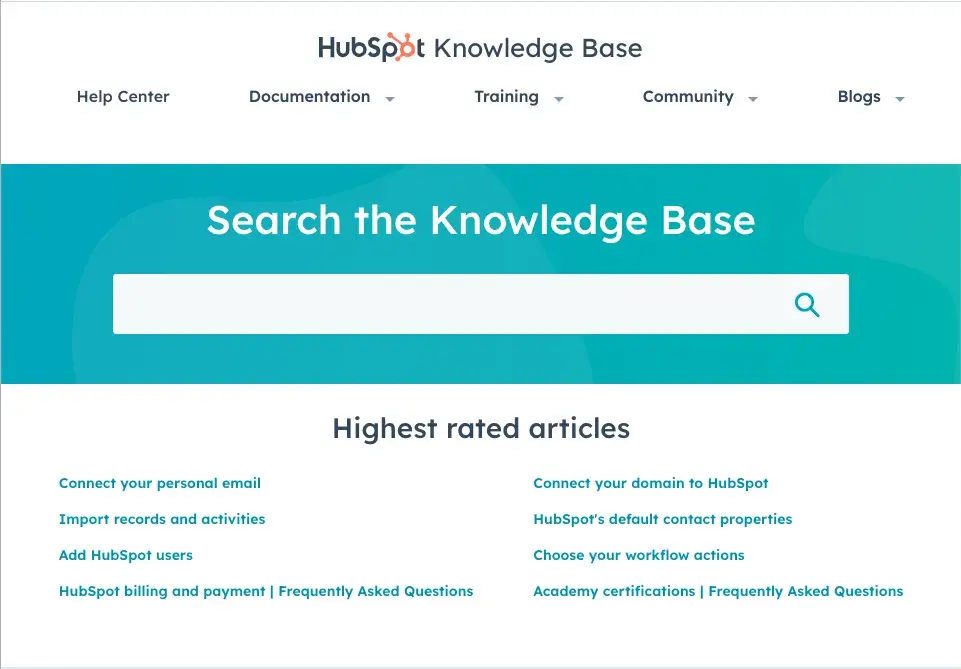Ready to learn more about knowledge bases, why they’re essential, and how to build one? I’ve got you covered. Check out the table of contents below to see what I’ll discuss, and jump down to any section that catches your eye.
Table of Contents
Knowledge Base Definition
A knowledge base is a centralized resource containing information and answers to help customers (or employees) find solutions to common questions, view step-by-step guides, and troubleshoot issues independently.
There are two main types of knowledge bases:
- Human-readable. Knowledge bases that are designed for real people to search, read, and interact with directly. Example: HubSpot Help Center. Most knowledge bases fall under this category.
- Machine-readable. Knowledge bases that are not publicly accessible for people to read and are only indexable by AI systems. People can then interact with those AI systems to receive self-service information.
What type of data is included in a knowledge base?
The content of your knowledge base depends on the complexity of your product and your business goals. Here are the main types of data you can expect to find in a comprehensive knowledge base.
- Product guides and tips. Step-by-step guides to help customers get the most out of your product or service.
- FAQs. Answers to common customer questions.
- Videos. Visual guides to help customers through complex processes.
- Company information that includes policies, hours, the company mission statement, history, and organizational updates.
- Department-specific knowledge. Internal knowledge bases should contain information on internal processes and best practices.
- Troubleshooting guides. These help customers or employees solve common technical issues.
Some businesses create content for general industry topics, not just their products. HubSpot is notorious for this, offering content to help and inspire marketers and salespeople to excel in their roles. This strategy, called Inbound Marketing, aims to attract customers through valuable content.
Why You Need a Knowledge Base
A well-executed knowledge base is invaluable to your customers, teams, and business as a whole. Here’s why:
1. It’s faster for your customers.
When I have a support question, the last thing I want to do is sit on hold or wait two days for an email reply. I want answers, and I want them now!
A knowledge base gives customers access to instant solutions for commonly asked questions. Using a knowledge base, customers can get answers to questions like “What’s your return policy?” or “How do I reset my password?” without ever needing to pick up the phone.
Empowering your customers to find answers and resolve issues independently saves time, increases customer satisfaction, and reduces frustration.
Pro tip: Save your customers even more time by surfacing relevant knowledge base articles directly in-app or on key website pages. For example, display a link to a password reset guide when logging in or highlight return policy information at checkout.
2. It lightens the load on your support team.
As a former support rep at HubSpot, I’ve seen firsthand how a knowledge base can reduce the number of incoming support tickets. When customers can solve various issues independently using self-service resources, support reps are granted more bandwidth to tackle pressing issues.
As a support rep, I used our knowledge base daily. I referenced our help articles in my troubleshooting and frequently shared relevant articles with customers at the end of our calls so they could tackle similar issues independently in the future.
Pro tip: Survey your customer service team to discover which knowledge base articles they share most often with customers and reference to solve issues. Prioritize updating those articles and creating new content to cover knowledge gaps.
3. It increases customer satisfaction.
A recent study found that 69% of customers prefer to solve issues independently before contacting support. Giving customers the self-service tools they need drives customer satisfaction and creates positive brand associations. I love it when I can use a knowledge base to solve issues for two main reasons: convenience and control.
- Convenience. Knowledge base resources let me find the information I need without waiting on hold or explaining myself via email. Self-service resources are quick, easy, and available around the clock.
- Control. Solving issues independently is empowering. Troubleshooting a problem on my own strengthens my trust and emotional relationship with a brand.
Pro tip: Implement feedback mechanisms on your knowledge base to discover which resources your customers find most helpful and which need attention.
4. It streamlines employee onboarding and training.
Knowledge bases aren’t just for customers. An internal knowledge base is an invaluable resource for employees looking for a single source of truth on company policies and department-specific knowledge.
As a new hire at HubSpot, I frequently referenced our internal knowledge base to fill in gaps between trainings, refresh myself on customer service protocols, and find out when the barista would be on site so I could get a free latte (I miss that).
An internal knowledge base allows new hires to become more productive faster with around-the-clock access to company knowledge resources. It also relieves pressure on senior team members who might otherwise be inundated with questions outside training.
An effective onboarding process can boost new-hire retention by up to 82%, so set them up for success with knowledge resources to make onboarding a breeze.
Pro tip: Include a section on company culture in your internal knowledge base to ensure everyone is aware of team values, communication norms, and fun traditions.
How to Build a Knowledge Base
Building a comprehensive knowledge base may seem daunting, but I have your back. Here is a step-by-step guide to creating one that streamlines internal processes and boosts customer satisfaction.
1. Define objectives and scope.
Are you creating a customer-facing knowledge base for self-service or an internal knowledge base to serve as your organization’s single source of truth?
Before you write your first article, you must define your goals and the purpose of your knowledge base. Are you looking to reduce support tickets and empower customers with self-service options, or are you looking to streamline onboarding and eliminate company data silos?
2. Define the structural elements of your knowledge base.
Consider what your customers expect to see when visiting a knowledge base. I wish to see a prominently featured search bar and quick access to the most popular help articles.
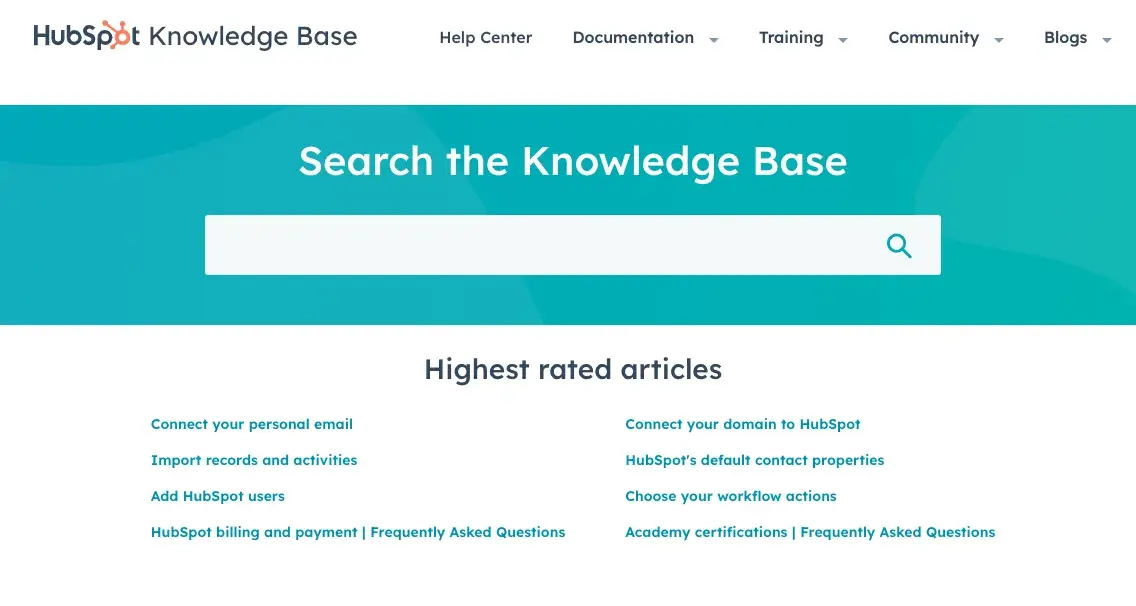
Here’s an example from HubSpot’s Knowledge Base that demonstrates the above-mentioned elements. If you use Knowledge Base software like HubSpot, you’ll have access to all of these features and more right out of the box, so you can focus on creating the content instead of worrying about web page design.
Some more elements I expect to see in a knowledge base are an FAQ section and an area where I can click to contact support quickly via email, phone, or live chat.
3. Identify key categories and topics.
Define the essential knowledge areas you need to cover and organize them into categories to create a structured framework for your content creation. Starting an entire knowledge base from scratch is a big task, but it becomes much more manageable when you break it up into smaller parts.
I often feel overwhelmed when I first start working on one of these blog posts, and I’ve found the key is to break it down into parts, devise an order of execution, and take things one at a time. The same thing applies to creating a knowledge base.
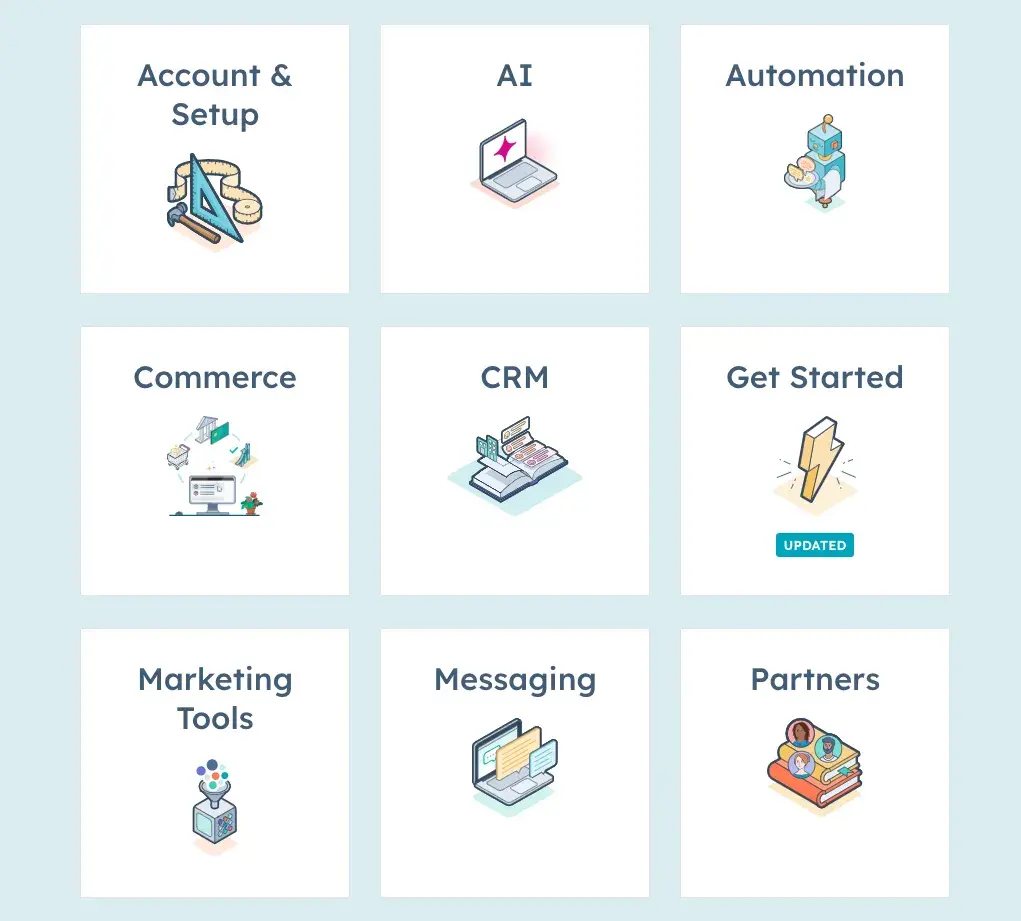
I recommend checking out other knowledge bases to see how they organize their content. Above is a screenshot from HubSpot’s Knowledge Base, which breaks up content into logical categories based on product areas and specific features. Think about how you can apply the same logic to your product or service, and I guarantee the once-daunting mountain of content will start to seem more manageable.
4. Select your contributors.
Creating content for a knowledge base is a team effort. You should select knowledge base writers who are experts in the content area and regularly interact with customers. In my biased opinion, as a former support rep, service team members are uniquely equipped for knowledge base contributions since they have an intimate understanding of customers’ needs and a high-level understanding of the products they support.
Pro tip: You might also need to recruit more technical team members, such as engineers or product managers, to create technical documentation or advanced troubleshooting guides.
5. Create a style guide.
Your knowledge base content should have a consistent format and tone that reflects your brand ethos. That can be a challenge when multiple contributors write articles on various topics, but a style guide helps solve that problem (and you can host it on an internal knowledge base).
Here are some things you might cover in your style guide:
- Tone and language. Should it be conversational and friendly or professional and direct? Will you be writing in the first person? These answers depend heavily on your brand identity.
- Formatting. Ensure consistent use of headings, bullets, images, and other rich content to make your content digestible.
- Terminology. Establish consistent use of technical terms, product names, and abbreviations that will make multiple appearances throughout your content.
Pro tip: Include actual writing samples in your style guide so contributors clearly understand expectations.
6. Gather and curate information.
Now, we’re starting to get into the fun part. Your organization likely has some existing documentation and internal resources; the key is to consolidate and refine.
Gather and analyze your existing information, ensure it is up-to-date and comprehensive, and identify the gaps you need to fill with brand-new documentation. Now is also the time to remove and edit duplicate or outdated information to ensure it matches your brand style guide for tone, format, and consistency.
Pro tip: Now is the time to bust out the spreadsheets. A simple spreadsheet can help you track and organize existing content you’d like to integrate into your knowledge base.
7. Choose a platform.
A knowledge management platform makes creating and maintaining a knowledge base a breeze. Choosing the right one to scale with your business is crucial. Luckily, I’ve already done the work for you.
I tested out the top knowledge base platforms and reviewed my favorites here.
When choosing a platform to host your knowledge base, here are some things you should consider:
- Search functionality. Customers need access to a high-powered search bar to find appropriate articles quickly. Many platforms today feature AI-assisted search and chatbots to make navigating your knowledge base content even more seamless.
- Categorization and tagging. As I mentioned before, organizing your content is key. Choose a platform that lets you easily categorize and tag articles so they automatically appear in the associated section of your knowledge base.
- Collaboration tools. The best knowledge base tools feature Google Docs-like collaborative editing features so multiple contributors and editors can work on the same piece simultaneously. Team members should also be able to suggest edits and new content quickly.
- Mobile responsiveness. This one almost goes without saying. Your knowledge base has to work smoothly on mobile and desktop.
- Analytics and reporting. Choose a platform that lets you identify trends, track page views, and measure customer engagement with individual content on your knowledge base. This is crucial information for identifying knowledge gaps, keeping articles up to date, and even discovering areas of your product that need some work.
8. Write the content.
Wow, I can’t believe we made it all the way to step 8 before talking about actually writing knowledge base articles. Now is the time to write the content. It’s the fun part, right?
Start by focusing on a common customer issue you can solve with appropriate documentation. Remember, the goal of your writing is to be helpful, clear, and actionable. Give your customers the answers they are looking for without making them wade through extra fluff.
Here are some tips for writing effective knowledge base content:
- Use simple language. I love jargon as much as the next guy, but there’s a time and place.
- Be direct. You know when you find a recipe online, and the author waxes poetic for seven paragraphs before telling you what temperature to preheat the oven? Yeah, don’t do that. Get to the point.
- Format for skimming. I can’t remember the last time I actually read a knowledge base article from start to finish. Use subheadings, bullets, and a table of contents so customers can jump to the information they need.
- Add visuals. Screenshots, GIFs, and video tutorials can elevate your content and make complex processes easier to follow.
Pro tip: You can use AI to help create your knowledge base content. It’s not cheating (unless it is). What I don’t recommend is that you let ChatGPT write your entire article. That’s not good.
However, you can write the content yourself, feed it to ChatGPT along with your brand style guide, and ask for suggestions to make it sharper and more consistent.
9. Gather feedback and update regularly.
A knowledge base is like the Constitution; it’s a living document. It needs to evolve alongside your business, your products, and, most importantly, your customers’ needs.
Once your knowledge base is live, start collecting feedback on your content. Most knowledge base software includes built-in analytics tools to track the performance of your posts. Some even feature AI tools that alert you when articles need updates or refinement.
Regularly auditing your knowledge base content will ensure you fill any gaps and leave no customer needs unaddressed.
Pro tip: Lean on your support team to spot out-of-date content and identify knowledge gaps. As a former frontline rep, I regularly flagged articles for review since I was diving into the documentation daily while troubleshooting.
Examples of Knowledge Bases
1. HubSpot Knowledge Base
Get started with HubSpot's Knowledge Base Software
HubSpot’s knowledge base is a textbook example of a knowledge base that empowers customers to find solutions independently. The search bar is prominently placed and lightning-fast. I love how it populates with appropriate knowledge base articles as soon as you type in a keyword:
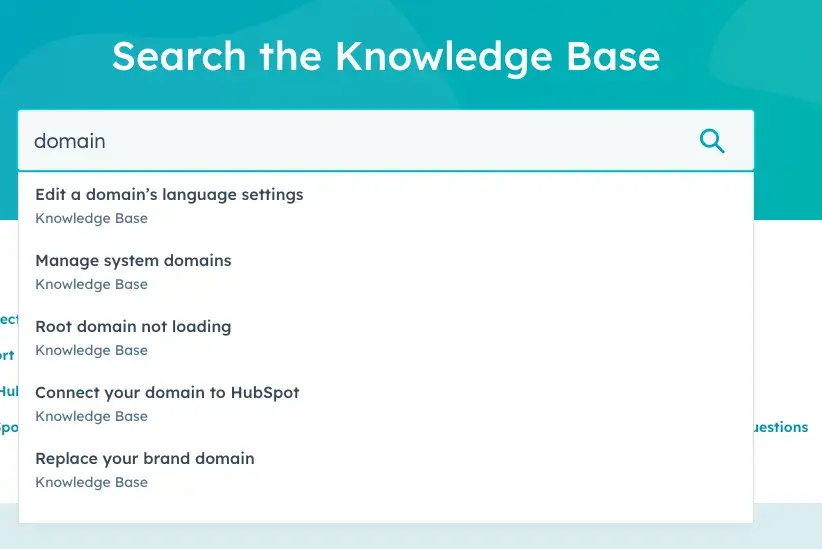
It also features links to the highest-rated articles on the knowledge base, which I always find helpful. Below, you’ll see attractive cards that separate knowledge content by logical categories. C’mon, I know you want to click one of those:
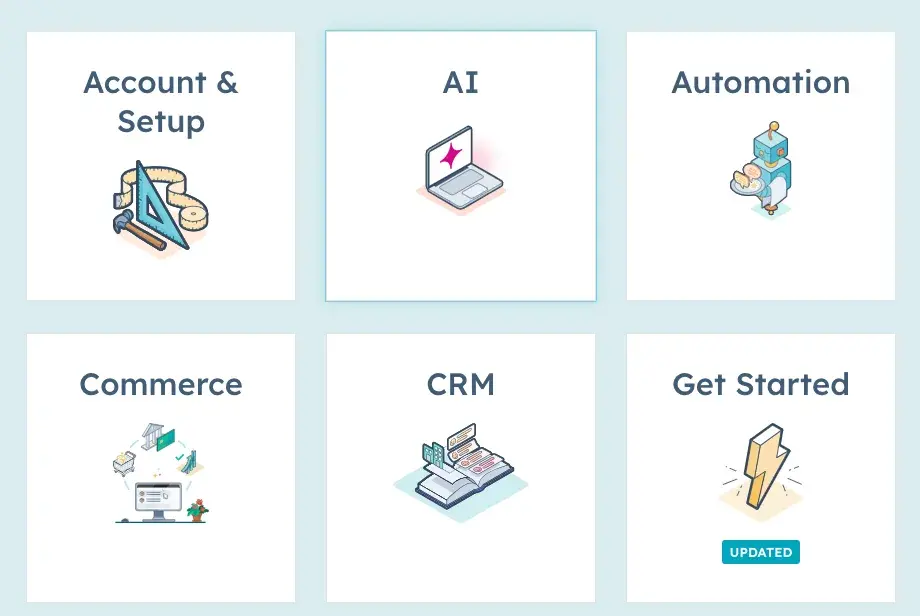
What I like: I like that HubSpot includes a Get Started section on its knowledge base. It gives new users a place to, well, get started, and the fact that it alerts me that it has been updated recently increases my confidence in the content and the brand.
Do you want to create a knowledge base just like HubSpot’s? I’ve got just the thing for you: HubSpot Knowledge Base Software.
2. HubSpot’s Help Center
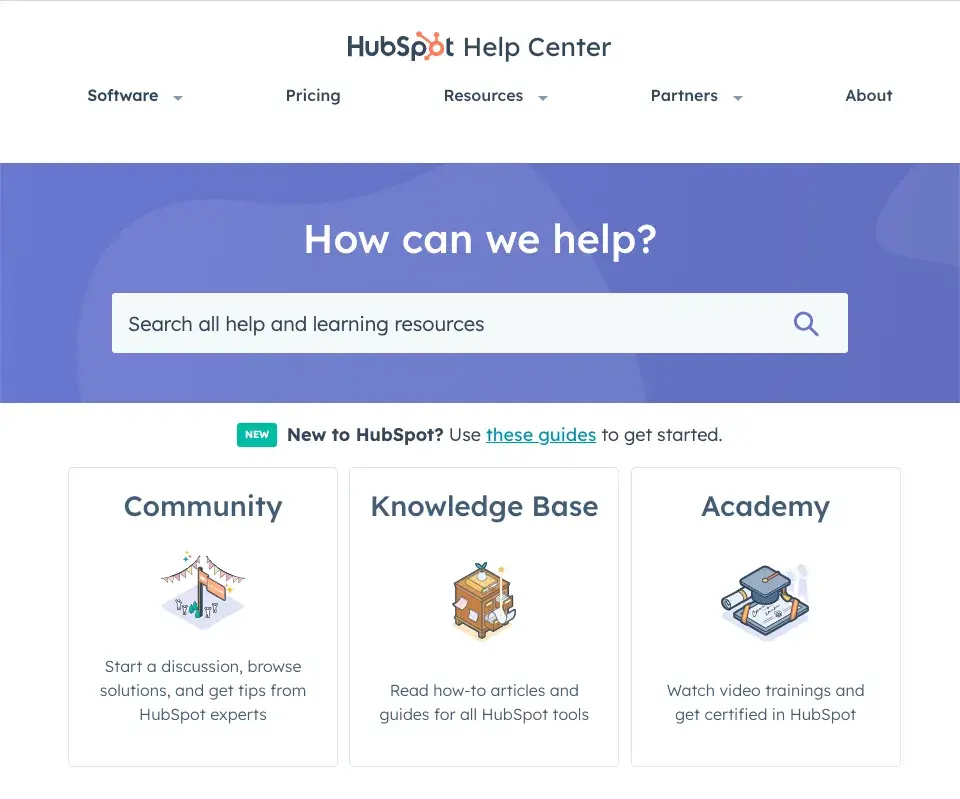
HubSpot’s Help Center is like the knowledge base of all HubSpot’s knowledge bases, if you will. It links to our self-service resources and product guides and is the home base of the HubSpot Community Forum, developer documentation, the HubSpot Academy, and more.
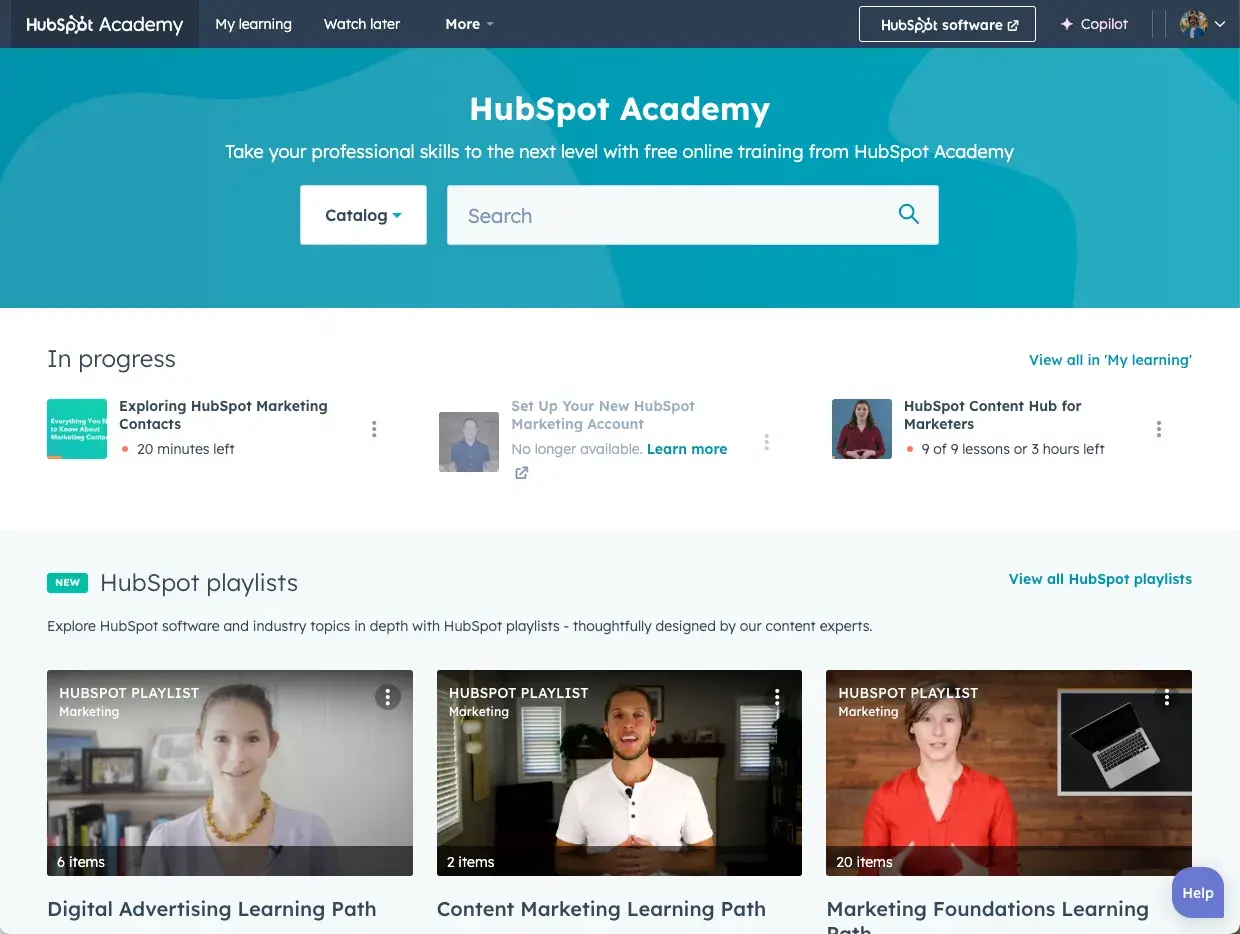
I love the HubSpot Academy because it goes beyond product documentation and troubleshooting guides and provides even deeper value to customers through classroom training, videos, and certifications. The HubSpot Academy is valuable to those who aren’t even HubSpot users. It contains training and videos on a variety of industry topics, such as web design, inbound marketing, AI, and operations.
Pro tip: HubSpot certifications are great for brushing up on key skills, and they look good on your resume.
Looking for more examples of top-tier knowledge bases for inspiration? I’ve compiled 20 of my favorites right here.
Bring Your Knowledge Base to Life
Working on this article has made it clear to me that a knowledge base is much more than a collection of articles. It’s an invaluable resource that drives customer satisfaction, empowers self-service, and supports your internal operations. A comprehensive knowledge base truly makes life easier for your customers and your team.
If you’re ready to create a knowledge base that your customers and employees will love, HubSpot’s Knowledge Base Management software is the best place to start.
Editor's note: This post was originally published in August 2018 and has been updated for comprehensiveness.
Knowledge Base
.png?width=112&height=112&name=Image%20Hackathon%20%E2%80%93%20Horizontal%20(14).png)

